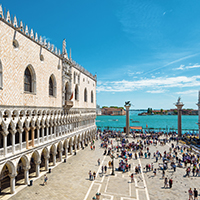Best Neighborhoods for Retirees in Rome
Summary: If you're retiring in Rome, here are some of the best neighborhoods in Rome for retirees.
Rome, the Eternal City, is not only a haven for tourists but also a delightful place for retirees seeking a blend of history, culture, and modern comforts. With its mild climate, excellent healthcare, and endless opportunities for leisure and exploration, Rome offers a variety of neighborhoods that cater to the preferences and needs of expats and retirees. From tranquil, green areas to bustling, historic centers, here are some of the best neighborhoods in Rome for retirees to call home.
Prati
Prati is known for its elegant buildings and proximity to the Vatican. Retirees can enjoy leisurely strolls along the wide, tree-lined avenues, visit the local markets, or explore the nearby Castel Sant'Angelo. The area is also home to several parks, such as the Piazza Cavour, where one can relax and enjoy the Roman sun. Cultural enthusiasts will appreciate the proximity to the Vatican Museums and St. Peter's Basilica.
Location: North of the Vatican City, across the Tiber River
Real Estate: Average rental price for a 2-bedroom apartment is around €1,500-€2,000 per month, while a 3-bedroom can go for €2,000-€2,500. Purchase prices average €6,000-€8,000 per square meter.
Healthcare: Prati offers access to several healthcare facilities, including the Ospedale Santo Spirito and private clinics.
Where to Eat: The neighborhood boasts a variety of restaurants, from traditional trattorias to upscale dining experiences.
Interesting History: Prati was developed in the late 19th and early 20th centuries, with its plan inspired by the modern boulevards of Paris.
Volunteer Organizations: Retirees can engage with community organizations such as the local Caritas, which often seeks volunteers for various social projects.
Parks: The neighborhood's green spaces include the Piazza Cavour and the nearby Villa Borghese, Rome's most famous park.
Trastevere
Trastevere is the quintessential Roman neighborhood, with its narrow cobblestone streets and vibrant atmosphere. It's a great place for retirees who enjoy a lively community feel and want to be immersed in authentic Roman culture. The area is filled with artisan shops, cafes, and restaurants. Retirees can spend their days exploring the historic Santa Maria in Trastevere Basilica or enjoying the scenic views from the Gianicolo Hill.
Location: South of the Vatican, on the west bank of the Tiber River
Real Estate: Rental prices for a 2-bedroom apartment range from €1,400-€1,800, while a 3-bedroom can cost €1,800-€2,400 per month. Purchase prices are around €5,500-€7,500 per square meter.
Healthcare: Trastevere is close to several hospitals, including the Fatebenefratelli Hospital on the Tiber Island.
Where to Eat: The neighborhood is famous for its traditional Roman eateries and picturesque outdoor dining spots.
Interesting History: Trastevere has a rich history, with roots stretching back to ancient Rome. The Santa Maria in Trastevere is one of the oldest churches in Rome, with mosaics dating back to the 12th century.
Volunteer Organizations: Opportunities for volunteering include community centers and church-related activities, especially at the Basilica of Santa Maria.
Parks: The Orto Botanico, Rome's botanical garden, is a peaceful retreat in the heart of Trastevere.
Aventino
Aventino is a peaceful and affluent neighborhood that offers retirees a serene environment with stunning views of the city. Known for its beautiful gardens and ancient churches, Aventino is perfect for those who appreciate quiet and greenery. The Orange Garden (Giardino degli Aranci) provides a tranquil space for relaxation, while the keyhole view at the Knights of Malta gate offers a unique perspective of St. Peter's Basilica.
Location: Central Rome, on the Aventine Hill
Real Estate: Rental prices for a 2-bedroom apartment are typically around €1,600-€2,100 per month, and a 3-bedroom can range from €2,100-€2,800. Purchase prices average €7,000-€9,000 per square meter.
Healthcare: The neighborhood is close to several reputable healthcare facilities, including the large San Camillo-Forlanini Hospital.
Where to Eat: Aventino has a selection of fine dining restaurants and cozy cafes that offer both Italian and international cuisine.
Interesting History: Aventino is one of Rome's seven hills and is steeped in history, with landmarks such as the Santa Sabina Church dating back to the 5th century.
Volunteer Organizations: There are various charitable organizations in the area, particularly those connected to the churches on the Aventine Hill.
Parks: The Orange Garden is the most popular park in the area, known for its beautiful orange trees and panoramic views.
Monteverde Vecchio
Monteverde Vecchio is a residential neighborhood that offers retirees a mix of tranquility and local Roman life. The area is characterized by its elegant villas and lush gardens. Retirees can enjoy the expansive Villa Pamphili park, the largest public park in Rome, perfect for walking, picnicking, and enjoying outdoor activities.
Location: West of Trastevere, atop the Janiculum Hill
Real Estate: Rental prices for a 2-bedroom apartment range from €1,200-€1,600 per month, while a 3-bedroom can cost €1,600-€2,200. Purchase prices average €5,000-€7,000 per square meter.
Healthcare: Monteverde Vecchio is close to several healthcare centers, including the San Camillo-Forlanini Hospital.
Where to Eat: The neighborhood has a variety of restaurants and cafes that offer traditional Roman dishes and modern cuisine.
Interesting History: Monteverde Vecchio is home to the Quattro Venti, a historic area known for its ancient wind rose.
Volunteer Organizations: Community involvement is possible through local parishes and non-profit organizations focused on social welfare.
Parks: Villa Pamphili is the neighborhood's crown jewel, offering a vast green space for recreation and relaxation.
Parioli
Parioli is one of Rome's most upscale neighborhoods, offering retirees an elegant and refined living experience. The area is known for its spacious apartments, modern amenities, and well-kept public areas. Retirees can enjoy cultural activities at the Auditorium Parco della Musica or visit the nearby Villa Borghese for art exhibitions and leisurely walks.
Location: North of the city center
Real Estate: Rental prices for a 2-bedroom apartment are around €1,800-€2,400 per month, and a 3-bedroom can range from €2,400-€3,000. Purchase prices average €7,500-€10,000 per square meter.
Healthcare: Parioli is close to several top-notch healthcare facilities, including the Villa Stuart Sport Clinic.
Where to Eat: The neighborhood boasts a selection of high-end restaurants and chic cafes.
Interesting History: Parioli was developed in the 1920s and 1930s as a garden city, with an emphasis on green spaces and elegant architecture.
Volunteer Organizations: There are opportunities for retirees to get involved with local cultural foundations and international clubs.
Parks: Villa Borghese and Villa Ada are two of the largest parks in Rome, both located within easy reach of Parioli.
Testaccio
Testaccio is a historic working-class neighborhood that has become increasingly popular with expats and retirees. It offers a real taste of Roman life, with its bustling market, traditional restaurants, and vibrant nightlife. The area is also home to the Monte dei Cocci, an ancient Roman potsherd hill, and the MACRO, a contemporary art museum.
Location: South of the city center, along the Tiber River
Real Estate: Rental prices for a 2-bedroom apartment are typically around €1,300-€1,700 per month, and a 3-bedroom can cost €1,700-€2,100. Purchase prices average €4,500-€6,500 per square meter.
Healthcare: Testaccio has access to several healthcare providers, including the nearby San Giovanni Hospital.
Where to Eat: The neighborhood is famous for its authentic Roman cuisine, with numerous trattorias and pizzerias.
Interesting History: Testaccio is known for its ancient history, including the Pyramid of Cestius, a remarkable pyramid tomb from 12 BC.
Volunteer Organizations: Retirees can participate in community initiatives and cultural associations in the area.
Parks: Testaccio doesn't have large parks, but the neighborhood's Piazza Santa Maria Liberatrice offers a pleasant public space.
EUR
EUR is a modern and well-planned neighborhood that was originally designed for the 1942 World's Fair. It's a great choice for retirees who prefer a more contemporary environment with wide avenues, modern buildings, and ample green spaces. The area is home to the Palazzo della Civilta Italiana, also known as the "Square Colosseum," and the beautiful EUR lake, ideal for leisurely walks.
Location: South of the city center
Real Estate: Rental prices for a 2-bedroom apartment range from €1,200-€1,600 per month, while a 3-bedroom can cost €1,600-€2,200. Purchase prices average €4,000-€6,000 per square meter.
Healthcare: EUR provides access to several healthcare facilities, including the IFO Regina Elena National Cancer Institute.
Where to Eat: The neighborhood offers a mix of traditional Italian restaurants and modern eateries.
Interesting History: EUR was envisioned by Mussolini as a symbol of the new Rome, with its architecture reflecting the Fascist era's grandeur.
Volunteer Organizations: There are various service clubs and international associations that welcome the participation of retirees.
Parks: The EUR district is known for its parks, including the Central Lake Park, which is a popular spot for relaxation and outdoor activities.
Garbatella
Garbatella is a charming and historic neighborhood with a strong sense of community, making it an attractive option for retirees. Its picturesque streets, garden squares, and unique architectural style provide a quaint and friendly atmosphere. The area has a rich cultural life with theaters, local festivals, and community events that retirees can enjoy.
Location: South of the city center, near Ostiense
Real Estate: Rental prices for a 2-bedroom apartment are around €1,100-€1,500 per month, and a 3-bedroom can range from €1,500-€2,000. Purchase prices average €3,500-€5,500 per square meter.
Healthcare: Garbatella is close to several hospitals and clinics, ensuring retirees have access to quality healthcare services.
Where to Eat: The neighborhood is home to a variety of dining options, from cozy cafes to traditional Roman trattorias.
Interesting History: Garbatella was established in the 1920s as a planned community to house workers, and its unique architectural style reflects the garden city movement.
Volunteer Organizations: Retirees can get involved with local cultural centers and social cooperatives that are active in the community.
Parks: Garbatella's small public gardens and squares offer green spaces for residents to enjoy the outdoors.
About the Author
 Joshua Wood, LPC joined Expat Exchange in 2000 and serves as one of its Co-Presidents. He is also one of the Founders of Digital Nomad Exchange. Prior to Expat Exchange, Joshua worked for NBC Cable (MSNBC and CNBC
Primetime). Joshua has a BA from Syracuse and a Master's in Clinical and Counseling Psychology from Fairleigh Dickinson University. Mr. Wood is also a licensed counselor and psychotherapist.
Joshua Wood, LPC joined Expat Exchange in 2000 and serves as one of its Co-Presidents. He is also one of the Founders of Digital Nomad Exchange. Prior to Expat Exchange, Joshua worked for NBC Cable (MSNBC and CNBC
Primetime). Joshua has a BA from Syracuse and a Master's in Clinical and Counseling Psychology from Fairleigh Dickinson University. Mr. Wood is also a licensed counselor and psychotherapist.
Some of Joshua's articles include Pros and Cons of Living in Portugal, 10 Best Places to Live in Ireland and Pros and Cons of Living in Uruguay. Connect with Joshua on LinkedIn.
Additional Information:
- Expat Guide to Rome
- The Insider's Guide to Rome
- Rome
- Healthcare & Health Insurance in Italy
- Best Places to Live in Italy
- Real Estate in Italy
- Is Health Insurance Required When Moving to Italy?
- What It's Like Living in Rome
- Pros and Cons of Living in Italy 2025
- 2025 Guide to Moving to Italy
- More Advice about Retiring in Italy




